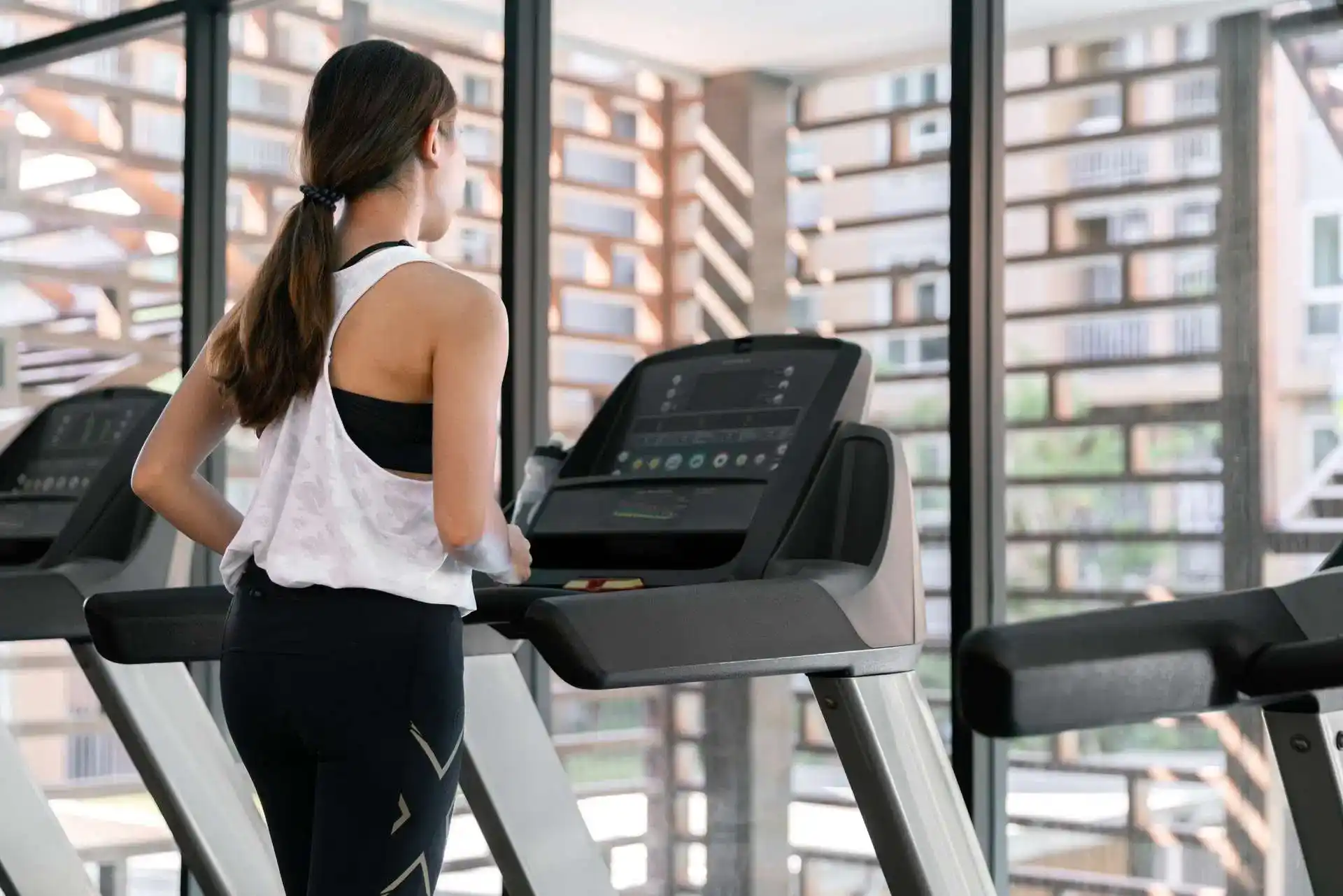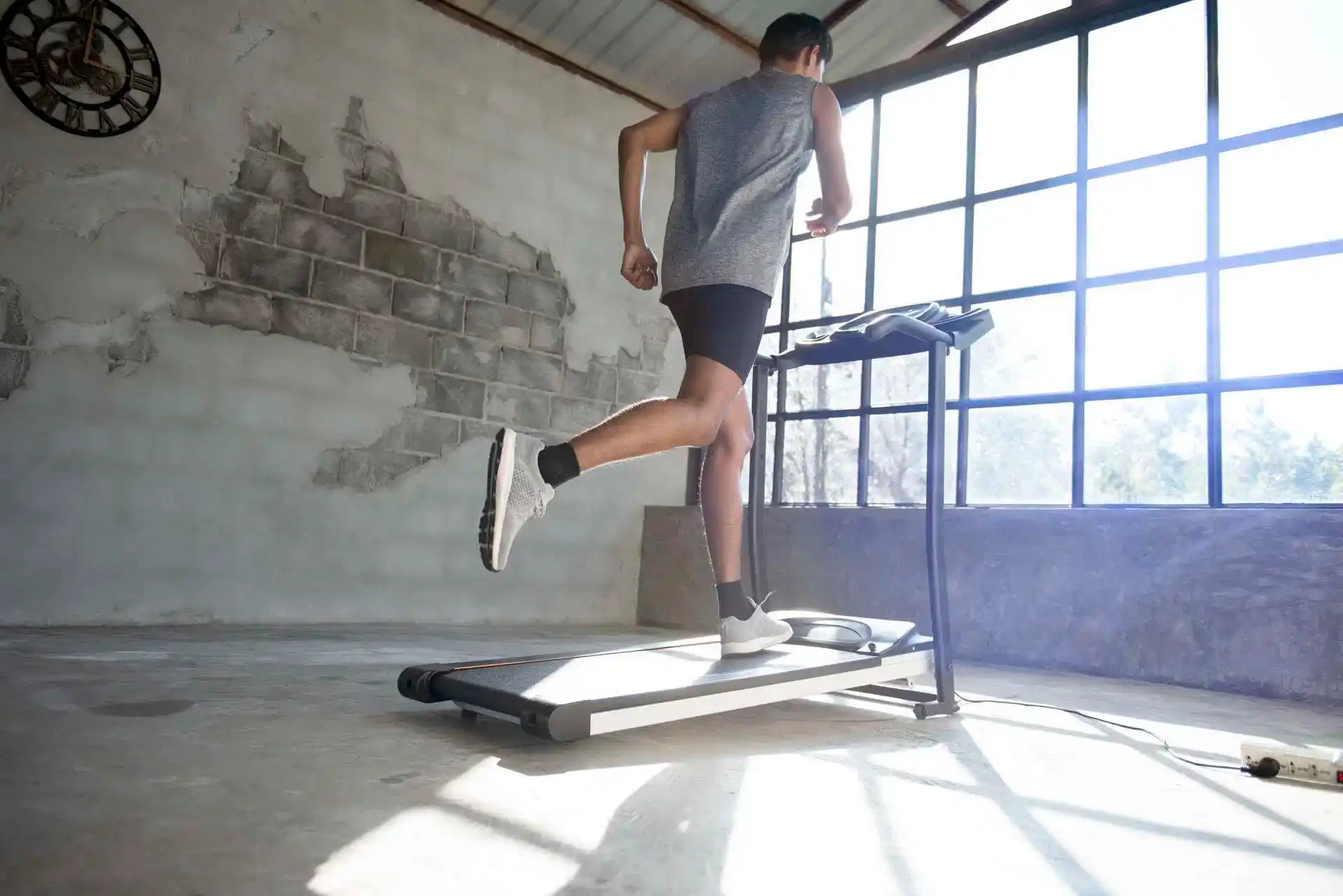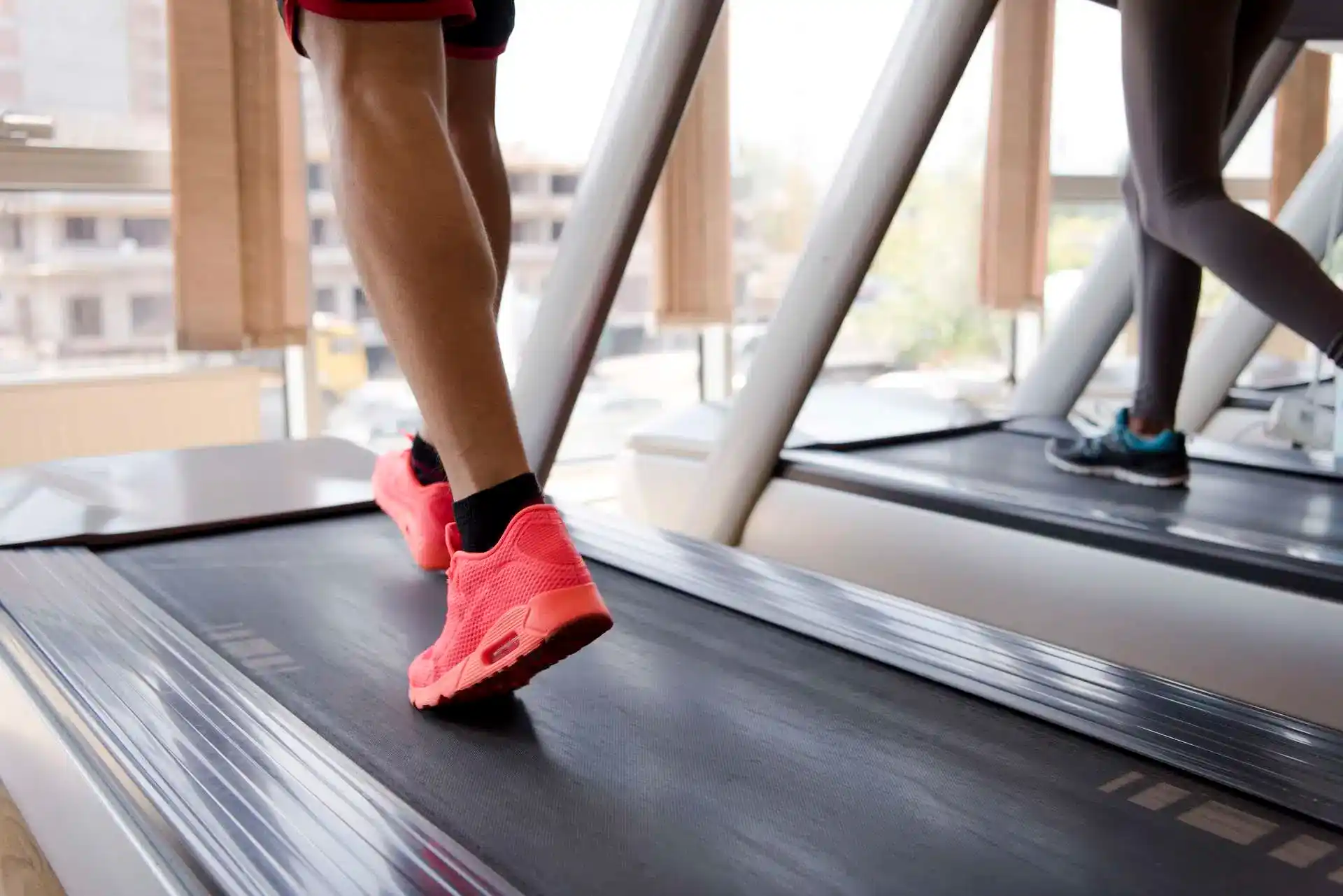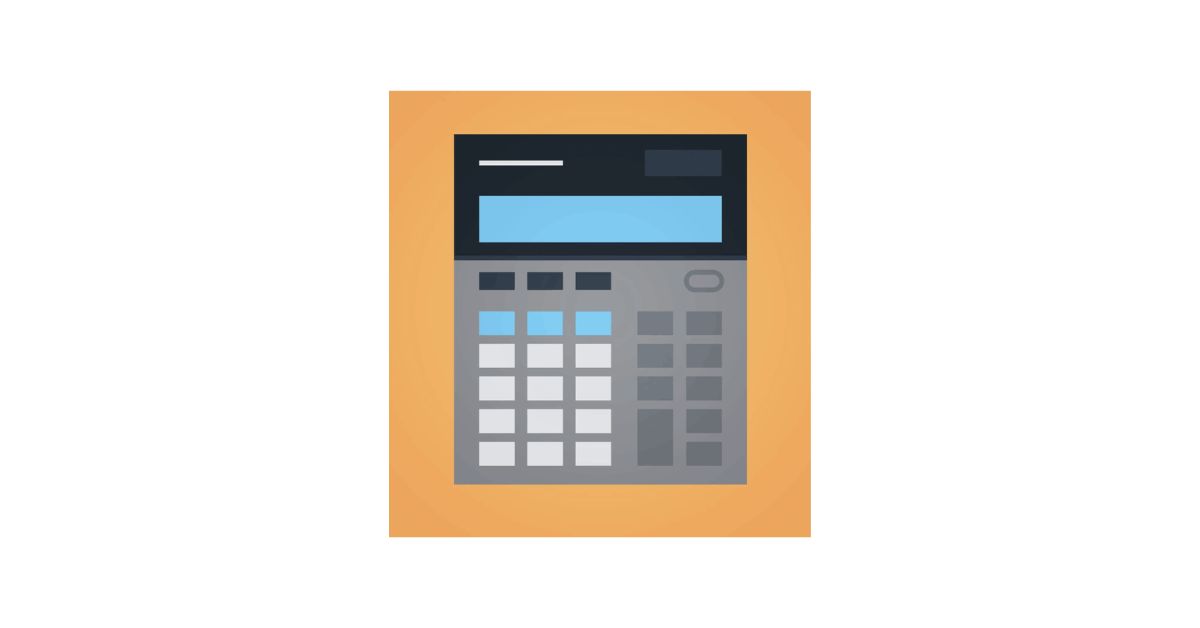If you want to run comfortably and not depend on the weather and nature, you can run on a treadmill instead of in the park. This option is preferable for several reasons.
Every gym has a treadmill, which can also be purchased for home exercise. The treadmill has high shock absorption, which significantly improves running quality.
To simulate air resistance, increase the treadmill’s incline by 1%. This will allow training in the gym to be similar to street training in terms of overall load level.
For quality training, you must know how to run on a treadmill correctly from the beginning.
- Basic Instructions for Running on a Treadmill
- How to Start Running on a Treadmill?
- Running Technique on a Treadmill for Beginners
- How Long and How Often Should a Beginner Run?
- How Much Should You Run to Lose Weight?
- Treadmill Inclination Angle
- Types of Running on a Treadmill
- Safety Running on a Treadmill
Basic Instructions for Running on a Treadmill

- Time: Allocating a free window on the treadmill for exercise is necessary. If you start running in the morning, continue at this time. How long you need to run on a treadmill is up to you, but doing less than 40 minutes will not be compelling enough.
- Motivation: choose an adequate goal for yourself. Some people run to increase their body’s endurance, others want to lose extra pounds, and others like to fight stress through physical activity.
- Plan: Create a clear training plan based on your motivation. For example, this will determine the results of your workouts on the treadmill.
- Regularity: Follow the plan regularly to consolidate the achievements of previous sessions; competent repetition and a gradual increase in the running load will allow you to get closer to your cherished goal quickly.
- Right gear: Discomfort and stiffness of movement significantly affect the quality of your workouts, so buy sportswear specifically for running on a treadmill and sneakers with good cushioning.
How to Start Running on a Treadmill?
Let’s start with the most important thing: how to use a treadmill for those dealing with this machine for the first time.
The question of how to run on a treadmill for a beginner deserves special consideration. For those who have not regularly exercised in recent months or have decided to exercise for the first time, trainers recommend starting with walking.
Thirty minutes of vigorous walking at 5 km/hour will help warm your muscles and strengthen your body. In the next session, you can move on to running after walking.
This should be done gradually: first, increase your walking speed to 6.5 km/h, then run.
Running Technique on a Treadmill for Beginners
- Place your foot directly under your body.
- Lower your toes smoothly rather than sticking them into the treadmill.
- Do not lean forward or backward; keep your back straight.
- You should not hold on to the treadmill handrails; it is best to bend your elbows at a 90-degree angle.
- Look not down but straight ahead.
Is it better to run or walk on a treadmill?
The correct answer is both! Here are a few more training rules for beginners. Start with a five-minute warm-up. It should be an easy walk that smoothly turns into a measured run. Warm-up is mandatory for both beginners and experienced runners.
Once you learn how to stand and run correctly on the treadmill, begin to master the programs and modes. The types of treadmill workouts depend on your chosen goal.
Changing the incline, increasing the speed, and measuring your HR (heart rate) will help you calculate the calories you burn.
Calculating your maximum heart rate is essential to choosing the most suitable treadmill training program. For example, running with a heart rate of 60-70% of your maximum will speed up the fat-burning process and develop endurance – 70-80%.
Monitoring your heart rate is extremely important for those who have just started working out on a treadmill in the gym. Beginners are advised to stick to 70% of their maximum heart rate.
This indicator can be reduced or increased only after the body adapts to training to achieve the desired goal. For example: HR max. = 205 – 0.74 x age (years). We multiply the resulting number by 0.70 and get the maximum heart rate for training.
If you are not “drying” on purpose, you should not forget about water during training. Keep a water bottle on the treadmill console to rehydrate your body occasionally.
Your treadmill workout is completed with a cool-down. You go into slow motion, returning to where you started the workout. Your pulse and breathing should return to normal.
How Long and How Often Should a Beginner Run?
The duration and frequency of training strictly depend on the goal and the body’s individual characteristics.
For example, 30 minutes of cardio 3-4 times a week will help you effectively lose weight. In one forty-minute workout, you can burn up to 700 calories.
Running on a treadmill can lose weight by 5-7 kilograms in 4 weeks of regular training. To increase endurance, you can run for less time but increase the treadmill’s incline and speed. How long you need to run on a treadmill is calculated individually.
To achieve the desired effect without harm to health, you first need to calculate precisely your indicators not to harm the body with an excessively high load.
For beginners, it is better to exercise 3-4 times a week at a low speed so the body will quickly switch to fat-burning mode, and you will not get tired quickly.
How Much Should You Run to Lose Weight?

How long should you run on a treadmill to lose weight?
The number of calories burned depends on the initial weight, muscle mass, and exercise intensity, so this indicator is calculated individually.
For reference, here are the average figures. After half an hour of running at 8 km/h on a flat surface, they will burn from 200 to 400 kcal, depending on weight.
Treadmills usually have a calorie counter, but for it to show more or less accurate values, you need to customize the machine for yourself: enter data about gender, age, weight, and heart rate sensor readings.
In this case, the meter readings can be trusted if you run correctly on a treadmill for weight loss. You can increase your energy expenditure by changing the slope of the track: the greater the upward slope, the more calories you will burn.
There are other secrets to running on a treadmill to lose weight.
Treadmill Inclination Angle
Beginners are recommended to run on a flat surface; in the future, you can change the inclination of the treadmill to complicate the workout.
The optimal incline angle for running is 4%; larger values can lead to injury. Modern treadmills typically feature training programs that vary in incline, similar to hill running.
In this case, the simulator will determine how long you should run on the treadmill with an incline and how long without. If there is no ready-made program, then during interval training, the inclination angle increases during the “explosion” and decreases during rest.
Types of Running on a Treadmill
Exercising on a treadmill allows you to simulate different types of running without being distracted by uneven surfaces or obstacles.
Plain running
The simplest type of training, suitable for beginners. In this case, the simulator belt is parallel to the floor.
How much you need to run on a treadmill and at what pace is up to you, depending on your capabilities, but remember that the difficulty of the workout should be gradually increased.
Hill running
Can you run up and down on a treadmill like on a cross-country track? Yes, most modern simulators provide such a program. Select it, and the treadmill will change the incline angle when needed.
Running this way is more interesting than running on a flat surface, and it is also more effective for losing weight and strengthening muscles.
Alternating running and walking
Such training is recommended for beginners. Depending on your level of fitness, you can walk or run on a treadmill at different time intervals.
To begin with, it is enough to spend a minute running and then a minute walking 10 times; in the future, the intervals can be increased.
Sprint
Sprint speeds range from 11 to 16 km/h and are intended for experienced users. The main task is to run as fast as possible within a short period.
Circuit training
Running on a treadmill at home or in the gym can become tedious at some point: music, videos, and dreams of a toned figure help. So, it’s time to diversify your activities. The good thing about circuit training is that it burns more calories in a short time than regular running.
Long run
It is only sometimes convenient to conduct such training in the gym, but at home, you can run on a treadmill for hours. In this case, the slope is slight, so you can’t run too fast.
Interval training
Alternating running at different speeds is a non-boring and effective option for more or less experienced athletes. As with circuit training, this activity burns more calories than regular monotonous running.
Safety Running on a Treadmill

Like other bulky exercise equipment with moving parts, the treadmill is potentially dangerous for users. Remember safety rules when using.
Modern treadmills have an emergency stop function with a key. It is inserted into a special connector, and its other end is attached to clothing. When you fall, the key pops out of the connector, and the simulator stops.
Only stand on the moving belt of the walkway after it is turned on. First, you must stand on the side fixed parts, turn on the simulator, and stand on it only when the belt starts moving.
Do not increase speed and incline at the same time. Be sure to turn off the machine before leaving it. Don’t jump off the moving walkway. Handrails are designed to help you maintain your balance.
However, you should not constantly hold on to them when running, as this increases the load on the spine. When using a treadmill, you must wear suitable clothing and shoes.
Clean running shoes are ideal. When running, you need to look forward and not at your feet not to get dizzy.



